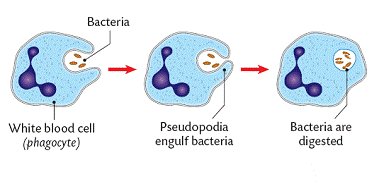body systems - responding to disease
1/11
Earn XP
Description and Tags
like diseases
Name | Mastery | Learn | Test | Matching | Spaced |
|---|
No study sessions yet.
12 Terms
define a disease
any impairment that prevents the body from normal function
define infectious disease
a disease which is able to be spread from one individual to another (ie, contagious) (e.g flu, covid)
define non-infectious disease
unspreadable disease (eg heart disease, diabetes)
Identify at least three examples of pathogens and the diseases caused by each
Viruses-covid19, HPV, Norovirus
Bacteria-E.coli, tuberculosis, pneumonia, meningitis
Fungi-Aspergillosis, blastomycosis, cryptococcus
Protozoa-Malaria, giardia, toxoplasmosis
explain first line of defence in our bodies
the first line of defence in bodies is our physical and chemical barriers, eg skin stomach acid and mucus lining. this prevents pathogens from entering body, hence helping prevent disease.
dead skin layer is water repellent and semi-antiseptic due to secreted oil, discouraging microbial growth.
blinking prevents pathogens, dirt and dust from harming eye by lubricating eye
mucus in nose and trachea traps pathogens and we sneeze/cough to expel them. cilia (fine cytoplasm threads that are like hair) prevent pathogens from reaching lungs.
list three examples of second line defence in our bodies
2nd line responds same way for each pathogen/innate defence
fever puts heat-induced stress on pathogens, inhibiting their growth or killing them, heat shock proteins produced by body when too hot that prevents body’s own cells from dying
white blood cells engulf foreign bodies and break them down to kill them
inflammatory response at a region sends chemical signals, leading to swelling which attracts white blood cells to the are
Recognise the difference between first, second and third lines of defense.
the first line of defence is a barrier that aims to prevent pathogens from entering the body
2nd line used if a pathogen does enter body. it is our innate response and is the same for all pathogens and it serves to kill pathogens.
3rd line is an specific/acquired immunity. lymphocytes (B cells produce antibodies neutralising viruses by binding to antigens, and T cells which kill cells infected by virus, not virus itself)
Recall at least one type of immunity and outline how it operates (acquired or natural)
2nd line - white blood cells, if they detect pathogens, will kill the pathogen by either engulfing and destroying the pathogen, or creating antibodies which can neutralise the pathogen.
the body can also start a fever, which results in higher than usual temperatures of the body, slowing the growth (division) of microorganisms, including pathogens.
inflammatory response attracts white blood cells to an area to kill pathogens (eg after cut)
Explain at least one example of how science is currently helping society respond to outbreaks of disease
rapid vaccine development - mRNA tech allowed scientists to create COVID-19 vaccines (pfizer, biontech, moderna) in a record time of around a year, when it typically takes multiple.
tech also allows scientists to quickly modify the mRNA to target variants of covid
what can abnormal cell behaviour result in?
cancer
Recall how non-infectious diseases (genetic, environmental, nutritional) are acquired. Give an example of each.
genetic diseases are acquired when there is either a mutation to the body’s genes, or if there is the wrong amount, eg down syndrome
environmental diseases are acquired when the body is exposed to substances in the surrounding environment that can make you sick e.g., lead poisoning
nutritional diseases are acquired from excessive or inadequate amounts of food and nutrients eg iron deficiency
how does white blood cell fight bacteria
